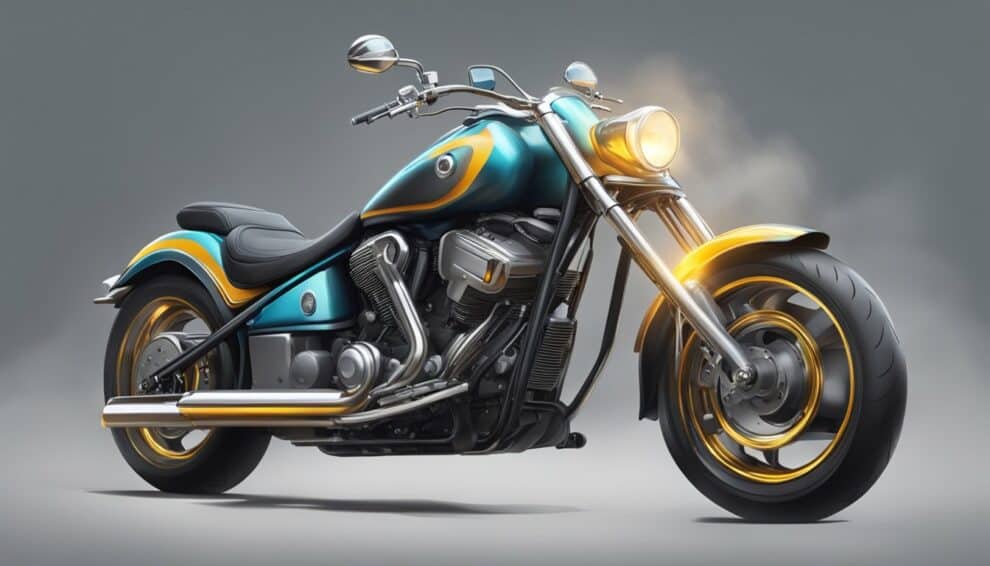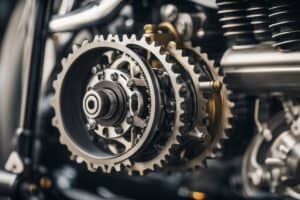Ever wondered why your motorcycle seems to guzzle more fuel when you’re pushing the speedometer to its limits?
It’s not just your imagination.
There’s a science behind why high speeds can lead to increased fuel consumption, and it’s crucial for bikers to understand.
At the heart of the matter are aerodynamics and engine efficiency, both of which play pivotal roles in your motorcycle’s thirst for fuel.
Let’s dive into what causes your two-wheeled beast to burn fuel faster as you chase the horizon.
How Aerodynamics Affect Fuel Consumption
When you’re zooming down the road on your motorcycle, aerodynamics play a crucial role in fuel efficiency.
Poor aerodynamics can cause your bike to work harder to cut through the air, which in turn burns more fuel.
Here’s why: As speed increases, the air resistance or drag on your motorcycle rises exponentially.
Imagine the air as a sea you’re trying to push through; at higher speeds, it’s like this sea gets thicker, slowing you down.
Motorcycles, especially sporty models, are designed with aerodynamics in mind, but they still face more resistance compared to streamlined vehicles like cars.
Wind resistance is the force that air exerts on your bike, and it increases with the square of your speed.
If you double your speed, the wind resistance quadruples, causing your engine to consume more fuel to maintain high speeds.
Frontal area and drag coefficient are key to aerodynamics.
The larger your bike’s frontal area, the more air it has to push away, which means higher fuel consumption.
Meanwhile, the drag coefficient measures how sleek your motorcycle is — a lower coefficient indicates better aerodynamics and less fuel needed to overcome air resistance.
Modifying your riding posture or opting for aftermarket fairings can improve these factors, cutting down on drag and, as a result, fuel usage.
Worth noting, weather conditions like headwinds can further affect aerodynamics.
If you’re battling against a strong wind, expect your motorcycle to burn more fuel, even if it’s aerodynamically optimized.
Keep this in mind when planning long rides or calculating the potential fuel costs of a trip.
By understanding how aerodynamics impact your motorcycle’s fuel consumption, you’re better equipped to make modifications or riding style adjustments that can lead to significant savings on fuel in the long run.
The Role of Engine Efficiency in Fuel Consumption
When you’re pushing your motorcycle to higher speeds, engine efficiency becomes a key player in how much fuel you burn.
An engine’s efficiency is its ability to convert the fuel’s chemical energy into mechanical energy — the less efficient your engine, the more fuel it needs to produce the same power.
Factors that impact engine efficiency include:
- Engine design: The technology and construction of the engine determine its inherent efficiency.
- Maintenance routine: Regular oil changes and air filter replacements can keep your engine running smoothly.
- Engine temperature: An engine that’s not at optimal temperature can consume more fuel.
As speed climbs, the demand for power forces your engine to work harder.
This increased workload can expose inefficiencies you might not notice at lower speeds.
Whether it’s suboptimal combustion processes or increased friction between engine components, these inefficiencies can lead to excessive fuel consumption.
You can improve your motorcycle’s engine efficiency by ensuring it is well-maintained and making modifications that promote better combustion and reduce mechanical losses.
For instance, installing a high-flow air filter or using fuel additives that clean the injectors can reduce the energy wasted and thus cut down on fuel usage.
Remember, while aerodynamics play a significant role in fuel consumption at high speeds, optimizing your engine’s performance is just as crucial for fuel economy.
With a finely tuned and efficient engine, you can manage fuel usage more effectively, even as you pick up pace and cut through the wind.
Factors That Can Lead to Excess Fuel Burn at High Speeds
You’re already aware that aerodynamics and engine efficiency play pivotal roles in your motorcycle’s fuel consumption.
But other factors can also cause your bike to guzzle more gas, especially when cruising at high speeds.
Tire condition and pressure are key contributors to fuel efficiency.
Improperly inflated tires increase rolling resistance, which in turn demands more power—and fuel—from the engine.
Make sure to check your tire pressure regularly in accordance with the manufacturer’s specifications to ensure optimal contact with the road.
Another often-overlooked factor is gear ratio selection.
The transmission’s gear ratios determine how the engine power is used to move your motorcycle.
A high gear ratio can be beneficial for top-speed performance but can also result in higher fuel burn rates as the engine maintains higher RPMs.
Understand your motorcycle’s gearing system and adjust your driving style respectively.
Additionally, weight and load distribution have a direct impact on how much fuel your bike burns.
Extra weight makes your motorcycle work harder.
Keep an eye on the total load, including accessories or luggage, and how it’s distributed across your bike, aiming for a balanced setup to promote fuel efficiency.
Lastly, don’t ignore the maintenance of auxiliary systems such as the electrical and the cooling.
Issues with these can cause the engine to run less efficiently, leading to increased fuel consumption.
Regular servicing will keep these systems in check, enabling your motorcycle to run smoothly and more economically.
The Impact of Motorcycle Design on Fuel Economy
When you’re evaluating your motorcycle’s fuel economy, design features of the bike play an integral part.
The very shape and structure of a motorcycle can determine how well it cuts through air resistance.
A sleek, aerodynamic body minimizes drag and allows you to maximize fuel efficiency even at elevated speeds.
Motorcycle fairings, the shell placed over the frame to reduce air drag, are crucial.
Bikes with full fairings can often achieve better fuel economy than those without due to reduced wind resistance.
However, the design must be a harmonious blend of form and function.
Overly complex or poorly designed fairings can create turbulence and paradoxically increase fuel consumption.
The seat and handlebar positions also affect your body’s aerodynamics and, in turn, fuel consumption.
Sportbikes with their lower handlebars and rear-set footpegs put you in a tucked position, aiding aerodynamics and improving fuel efficiency as opposed to the upright seating of traditional cruisers.
It’s also important to consider engine design.
Engines with advanced fuel injection systems offer a more precise control of the fuel-air mix, resulting in a burn that’s more complete, extracting maximum energy from each drop of fuel.
V-twin and inline-four engines differ vastly in how they manage airflow and combustion, thus influencing fuel economy.
Don’t overlook the weight of the motorcycle either.
Lighter materials such as carbon fiber might be more costly but contribute to overall efficiency.
Every pound shaved off the motorcycle’s weight means less energy required to propel it forward, which translates directly into savings at the gas pump.
By understanding how design impacts your bike’s fuel consumption, you can make informed choices that lead to a more economical ride.
Remember, it’s the blend of aerodynamics, engine technology, and weight management that ultimately determines fuel efficiency.
Frequently Asked Questions
What role does aerodynamics play in motorcycle fuel consumption?
Aerodynamics greatly impact fuel consumption by determining how much air resistance the motorcycle encounters.
Better aerodynamics, achieved through the motorcycle’s shape and the use of fairings, can significantly reduce air drag and improve fuel efficiency.
How does engine efficiency affect a motorcycle’s fuel usage?
Engine efficiency is crucial for fuel consumption.
A well-tuned engine with advanced technologies can convert more of the fuel’s energy into motion, leading to lower fuel use and better mileage.
Can tire condition influence motorcycle fuel economy?
Yes, tires that are worn out or not inflated properly increase rolling resistance, which requires more energy and fuel to maintain speed.
Consistent tire maintenance is vital for optimizing fuel consumption.
What is the effect of weight on a motorcycle’s fuel efficiency?
Increased weight on a motorcycle necessitates more energy for movement, which can lead to higher fuel consumption.
Effective load distribution and weight management can enhance fuel economy.
How does gear ratio selection contribute to fuel consumption?
Gear ratio selection impacts the engine’s operating efficiency.
Riding in the appropriate gear ensures the engine isn’t overworked, which can maintain better fuel efficiency.
Why is maintaining auxiliary systems important for motorcycle fuel efficiency?
Auxiliary systems, such as the electrical system or cooling system, draw power from the engine.
Keeping them well-maintained ensures they operate efficiently, preventing unnecessary fuel use.
What design features of a motorcycle are important for fuel economy?
Motorcycle design features that are important for fuel economy include the overall shape, structural design, seat and handlebar positioning, and the incorporation of fairings to reduce air resistance.
These features can all contribute to enhanced aerodynamic performance and fuel savings.
How does understanding motorcycle design improve fuel economy?
By understanding the elements of motorcycle design that affect fuel consumption, riders can make informed decisions about modifications and riding techniques that can lead to a more economical ride, reducing fuel costs and environmental impact.
As an Amazon Associate we earn from qualifying purchases.










